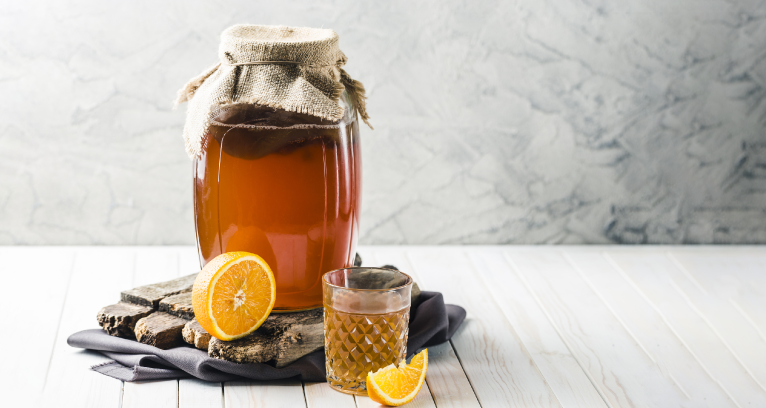
Excerpts from “Kombucha Health-Promoting Brew” by Diana Allen, MS, CNS
There’s a new drink in town, and it’s making a splash. Kombucha, a bubbly brew made from cultured sweet tea, was originally an ancient beverage bursting with benefits. Today kombucha appeals to a wide range of consumers—from health nuts to hipsters, from homemakers to homesteaders, and beyond.
Brewing quietly in glass jars across America, shared between friends and neighbors, spawning dozens of cottage industries world-wide and even attracting the interest of international beverage industry giants, kombucha’s star is on the rise. What is this strangely wonderful fizzy drink of murky origin? Why are so many people starting to drink it, and is it right for you?
Kombucha is a naturally fermented beverage, easily made in one’s own kitchen with just a few ingredients: tea, sugar and a “mother” culture to activate the fermentation process. During the past decade, kombucha’s do-it-yourself appeal and numerous reported health benefits made the tangy drink an instant hit with people interested in holistic nutrition, natural health and food sustainability. As a living food, kombucha also appeals to raw foodists. However, despite suggestive label claims, kombucha is not technically a raw food since it is made from boiled, sugared tea. Rather, kombucha is a living food, containing active enzymes and live, probiotic microorganisms.
Kombucha’s buzz emanates strongly from the traditional foods movement, particularly at the locavore level. (Locavores base their diet on foods produced within a 100-mile radius of home.) Modern home brewers are passionate about their “booch” and enthusiastically distribute a wealth of kombucha information, facts and opinions over the Internet.
Sales of ready-to-drink kombucha tea grew at an exponential rate during the first decade of the 21st century. Nevertheless, the brew is still unfamiliar to many consumers and food scientists. To illustrate its largely underground status, try searching “kombucha” on YouTube. More than 700 instructional and educational videos result. Search the same term in PubMed.com, the database of the U.S. Library of Medicine, National Institutes of Health, and the number of results dwindles to 40.
The 40 kombucha studies listed on PubMed.com, published between 1990 and 2010, address different features, benefits and concerns related to the naturally bubbly drink. Some studies simply discuss nutritional components of kombucha. Others suggest the potential ability of kombucha to improve health. Studies have shown kombucha promotes longevity in mice, fights oxidative stress, serves as a probiotic and boosts immune function.
So what is Kombucha?
Kombucha is a naturally fermented traditional beverage made from a mother culture and ordinary sweetened tea—black, green or a combination of both. The mother culture is a living organism containing biologically active, people-friendly yeasts and bacteria embedded in a cellulose matrix. These microorganisms carry out the fermentation process to produce organic acids and trace amounts of alcohol in the process. It takes one or more weeks for a kombucha mother culture to adequately break down the sugars and other compounds in sweetened tea to yield a finished product. At the end, the original starter tea undergoes a total transformation and is reborn as the fizzy, slightly sweet, slightly sour drink known as kombucha.
Tea and sugar sure, but what in the world is “mother culture?”
Along with tea and sugar, a mother culture is the third ingredient required to make kombucha tea. This culture is present and active in all unpasteurized, “raw” kombucha, although it may not be visible to the naked eye. The kombucha culture is a living food. Resembling a rubbery, golden-colored pancake when mature, the culture has the alchemical power to transform ordinary sweetened tea into a fizzy, tangy, health-supportive beverage through a dual fermentation process carried out by two types of microorganisms: bacteria and yeasts.
History of Kombucha
No one knows for certain exactly when or where people first started making kombucha or using it as a folk remedy. Old Testament references to a “vinegar drink” (Ruth 2:14) are evocative of kombucha but tea was unknown in that biblical time and region. Most likely, kombucha hails from the Far East, where tea originated. Kombucha has been a traditional beverage in China, Japan and Korea for many centuries, and in Russia and Poland (by way of Manchuria) for generations.
According to another legend, kombucha earned its name due to an error in identification when it was mistaken for a fermented Japanese brew made from kombu seaweed (again, “kombu-tea” or “kombu-cha”). Early German research that suggests Japanese origins for kombucha may support this version of the story.
The Modern Kombucha Market
By the year 2000, a handful of companies in the United States were producing kombucha. Within ten years, kombucha became one of the fastest growing segments in the beverage industry. Small, home-based cottage producers abound, and powerful players have taken notice. In 2008, for example, Coca-Cola Co. purchased a 40% stake in Honest Tea, a manufacturer of ready-to-drink tea beverages including a kombucha line, Honest Kombucha.
Now coming into its own as a delicious, healthy alternative to soft drinks and alcoholic beverages, trendy kombucha has even started to appear as an ingredient in diverse products—from skin lotion to sorbet. As a beverage, ready-to-drink kombucha comes in many flavors. It can be enjoyed plain or mixed with fruit juices and other flavorings. Raw food restaurants serve creative kombucha cocktails and the trend is catching on. Low calorie kombucha supplies far more nutritional benefits than sugary sodas. And unlike fellow fermented beverages, beer and wine, kombucha actually boosts liver health and detox function. As an added bonus, you can easily make it yourself for just pennies a serving.
Health Benefits
Kombucha has been credited with numerous benefits, from supporting digestive and immune health to detoxifying the liver, boosting energy, improving mood and well-being and more.
Many kombucha health claims are rooted in ancient sources and folk wisdom. Others are the conclusions of medical use and research. When the drink was introduced into Russian and German hospitals during the early and mid 20th century, researchers used it as an effective way to help with a wide range of ailments: arthritis, arteriosclerosis, asthma, cancer, constipation, diabetes, fatigue, gallbladder problems, gout, headaches, high blood pressure, high cholesterol, indigestion, inflammatory bowel disease, kidney stones, rheumatism, skin conditions and more.
Since 1990, a small but compelling body of research has been carried out around the world investigating the health benefits of kombucha. Some of these published studies can be accessed on PubMed.com. The average consumer, however, is most likely to rely on modern popular sources of information about the fermented tea beverage such as books, online educational forums, company websites and person-to-person buzz. Use your power of discernment when trying to separate fact from fiction and rely on your own experience. Ultimately, personal experience with kombucha is the best guide in determining kombucha’s effect on your health and well being.
Low Calorie Refreshment
When enjoyed as a light sparkling beverage, kombucha satisfies the senses, hydrates the body and with only 35 calories per eight-ounce serving, may help support healthy weight goals and maintenance.
Digestive Support
Since ancient times, improved digestive health has been the number one reported benefit of drinking kombucha tea. Kombucha is widely considered an outstanding remedy for stomach discomfort. Many people with stomach discomfort report relief during flare-ups and a lessening of general symptoms. Chronic and acute indigestion or dyspepsia also may be relieved by kombucha tea. Varieties with ginger added as a flavoring after brewing may be of special use in this regard.
The mechanisms for kombucha’s digestive benefits begin in the stomach, where the acidic pH of the drink complements the acid pH of healthy stomach conditions. The living enzymes in kombucha tea may help to complement the activity of the body’s own digestive enzymes and assist in the breakdown of foods. In the intestines, kombucha’s organic acids and probiotics help to balance the internal environment and support the growth of healthy gut flora. Overall, kombucha is considered an excellent digestive tonic.
Immune Support
Toxins and pathogens can infiltrate the human body through three major points of entry: airways, skin and the gastro-intestinal (GI) tract. The GI tract is the first contact for the majority of unwanted substances coming from the outside world. Approximately 60 to 70 percent of the immune system is housed in the gut to help protect us from foreign invaders. This is where kombucha offers assistance, beginning in the stomach.
Beyond the stomach, kombucha supports the enterocytes—short-lived cells that line the intestinal walls. Enterocytes supply immune support with tight intercellular junctions, detoxification enzymes and gut-associated lymphoid tissue. Kombucha helps nourish colonic enterocytes by providing probiotic yeasts and bacteria that process fiber from the diet into butyrate, a short chain fatty acid that is the primary fuel for enterocytes and has been suggested to help support the body when faced with colon cancer. When enterocytes are well nourished, illnesses caused by toxins and foreign pathogens in the gut are far less likely to take hold.
Kombucha also directly provides butyric acid, along with other organic acids such as glucuronic, gluconic and malic acids, all of which help to upregulate detoxification enzymes in the intestinal
walls and the liver, the body’s primary detox organ. By assisting in the elimination of toxins from the body, organic acids in kombucha help to decrease the total body burden of toxins, contributing to improved health and a fortified immune system.
Liver Detoxification
In order to survive, the body must continuously eliminate toxins—from pesticide residues and chemical additives in food to tobacco smoke, industrial pollutants, pharmaceutical drugs, synthetic fragrances, exhaust fumes, harsh cleaning products and more. Because toxins are everywhere, proper detoxification function is critical.
Most environmental toxins are fat-soluble compounds that must undergo a process of biotransformation in the liver. Once turned into water-soluble compounds in the liver, toxins can be released from the body via the superhighways of elimination: bowel and bladder. The biotransformation process cannot take place unless certain nutrient cofactors, many of which must be consumed in food, are present in the liver.
Kombucha is packed with detox cofactors that can help promote liver detox systems and the elimination of toxic substances from the body. Kombucha made with green tea is further spiked with catechins that have been shown to boost production of glutathione S-transferase (GST), a key enzyme used in liver detoxification.
Energetic and Emotional Health
Most people who regularly consume kombucha rave about enhanced energy. Some of this can be attributed to the subtle caloric contribution and caffeine content of sweetened tea. But drinkers of the brew may also experience mild euphoria, relaxation and an overall
sense of well-being—effects beyond the scope of sugar and caffeine.
One woman from Kansas City, Missouri, a ten-year veteran kombucha drinker, credits the brew not only with relieving her digestive issues but also with boosting her vitality level. “Kombucha gives me energy,” she says. “You can tell it’s a living food.”
Kombucha exists in symbiosis not only with itself, but also with people. This interaction represents a remarkable relationship between single celled organisms—among the oldest and simplest life forms on earth—and human beings, among the most complexly evolved beings known to exist. We provide the sweet tea needed by kombucha microbes to grow and reproduce. It, in turn, provides us with a pleasing, healthful beverage.
If we accept (not that you necessarily have to!) that all life has an energetic-spiritual foundation and consider that kombucha is a living food or being, it is not a leap to associate the sparkling beverage with energetic-spiritual attributes. With this in mind, the fact that many kombucha drinkers experience feelings of bliss, connectedness and spiritual receptivity in addition to improved health and well-being surely warrants thoughtful consideration.
References
Consumer Federation of America. “Alcohol Facts.” June 2008. www.consumerfed.org.
Ernst E. “Kombucha: a systematic review of the clinical evidence.” Forsch Komplementarmed Klass Naturheilkd. 10, no. 2 (April 2003): 85-7.
Fermented Foods Discussion Board. “Kombucha: Side effects, risks and warnings.” http://www.welltellme.com/discuss/index.php?topic3305.0.
Gharib OA. “Effects of Kombucha on oxidative stress induced nephrotoxicity in rats.” Chinese Medicine. 27, no. 4 (Nov. 2009): 23.
Hartmann AM, et al. “Effects of chronic kombucha ingestion on open-field behaviors, longevity, appetitive behaviors, and organs in c57-bl/6 mice: a pilot study.” Nutrition. 16, no. 9 (Sept. 2000):755-61.
Mayser P, et al. “The yeast spectrum of the ’tea fungus Kombucha.’” Mycoses. 38, no.7–8 (July–Aug. 1995): 289-95.
Murugesan GS, et al. “Hepatoprotective and curative properties of Kombucha tea against carbon tetrachloride-induced toxicity. Journal of Microbiology and Biotechnology.” 19, no. 4 (April 2009): 397-402.
Pauline T, et al. “Studies on toxicity, anti-stress and hepato-protective properties of Kombucha tea.” Biomedical Environmental Science. 14, no. 3 (Sept. 2001): 207-13.
Roussin, MR. © 1996-2003 Analyses of Kombucha Ferments. Information Resources, LC http://www.kombucha-research.com, 2003. PDF e-book.
Sai Ram M, et al. “Effect of Kombucha tea on chromate (VI)-induced oxidative stress in albino rats. Journal of Ethnopharmacology. 71, no. 1–2 (July 2000): 235-40.
Shishehbor F, et al. “Apple cider vinegar attenuates lipid profile in normal and diabetic rats.”
Pakistan Journal of Biological Sciences. 11, no. 23 (Dec. 2008): 2634-2638.
Sreeramulu G, et al. “Kombucha fermentation and its antimicrobial activity.” Journal of Agricultural Food Chemistry. 48, no. 6 (June 2000): 2589-94.
Teoh AL, Heard G, Cox J. “Yeast ecology of Kombucha fermentation.” International Journal of Food Microbiology 95, no. 3 (1 Sept. 2004): 119–26.
Thomson S. “‘Kombucha’ Green Tea Symbiont: A Scientific Health Literature Review.” Gaia Research Institute, 2006. http://www.gaiaresearch.co.za/kombucha.html.
Tietze, Harald. 1996. Kombucha: The Miracle Fungus. Australia: PHREE Books.



